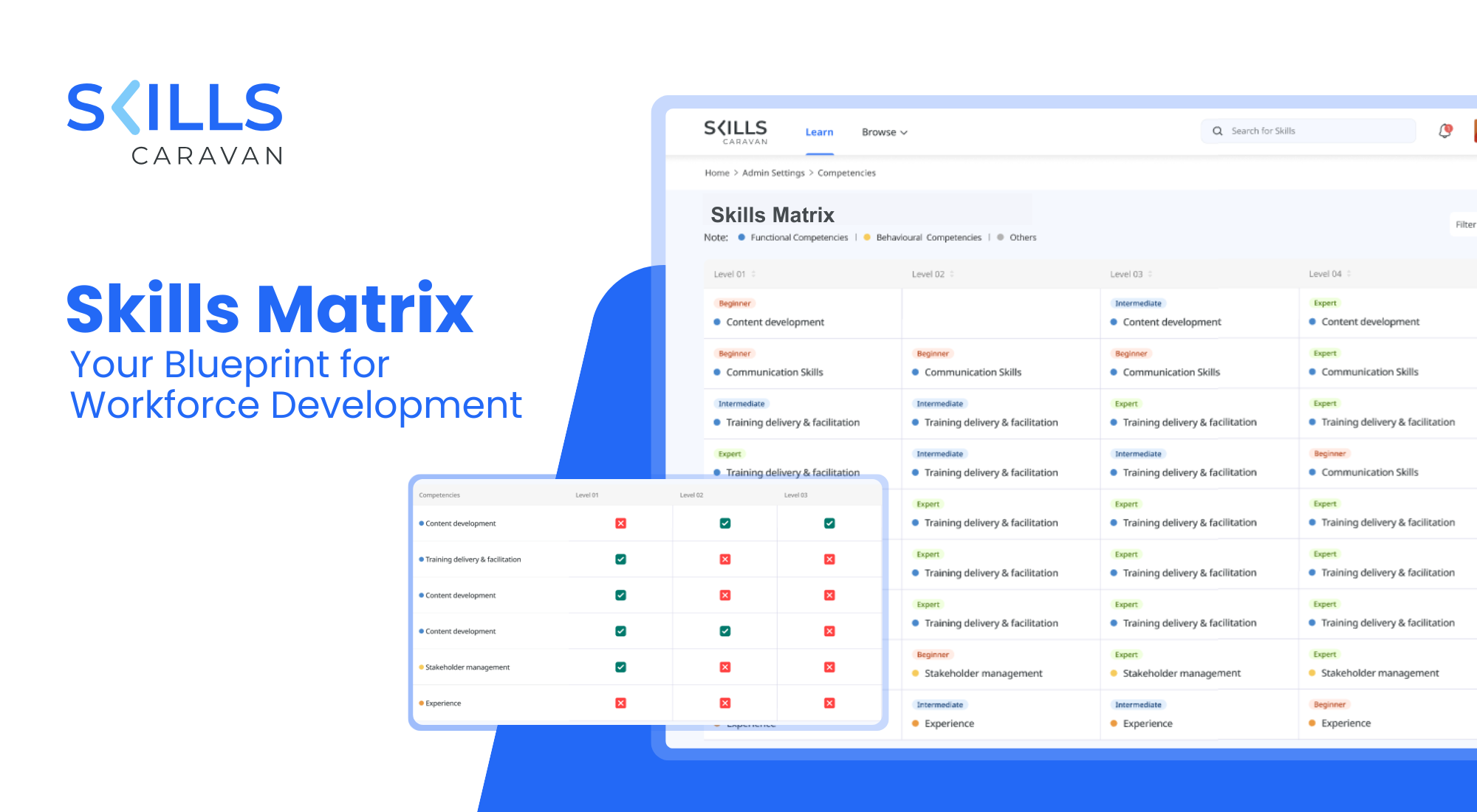AI Capability Matrix: A Strategic Framework for L&D Leaders to Drive Skill-Based Learning
.webp)
Most organisations have acknowledged that artificial intelligence is going to alter the way work is done, nevertheless they have not yet put that acknowledgement into a clear, tangible plan to skill people. L&D leaders are in a two-fold dilemma; they must choose the type of AI-related capabilities that are relevant to various roles and then develop learning aligned to those capabilities with actual business results.
An AI Capability Matrix is the answer to both questions as it transforms abstract AI ideas into an organised map of skills, proficiencies, and behaviours specific to particular jobs and levels. The matrix, when constructed effectively, is not merely a diagnostic, but is a decision tool, advising hiring, internal movement, learning opportunities, and performance indicators. Such a matrix provides a practical and immediate value, that is, it can eliminate the one-size-fits-all training, avoid unnecessary content, and enable L&D to demonstrate tangible results in comparison with actual role-based requirements.
What is an AI Capability Matrix?
An AI Capability Matrix is a two-dimensional framework where the vertical axis lists roles, job families, or career levels and the horizontal axis contains AI competencies, from foundational literacy (e.g., using productivity-boosting AI tools) through data fluency and prompt engineering, to specialist abilities such as model evaluation or ethical governance. Each cell describes the expected proficiency level for that role (for example: awareness, application with support, independent practitioner, or strategic owner).

Referring to it as a capability maturity, instead of a skills maturity, is an indication that the important thing here is not how well an individual understands AI but how well he or she can apply it in a responsible manner in the context of the environment, ask questions of the output, and refine the model findings into value-generating decisions. Instead of buzzwords, a good matrix identifies the strategic gaps that should be used to prioritize investments in learning based on the gaps identified by leaders.
Why L&D leaders need an AI Capability Matrix?
Organisations are hastening AI implementation, yet they are missing the governance and systematic learning to realise the benefits of AI in a safe and equitable manner. Surveys indicate that adoption is accelerating across functions, but adoption is not very mature yet and most employees do not have training relevant to their role; this disparity creates unequal capability and operational risk. The matrix is the intermediary between the business intent and people's readiness to L&D leaders: it allows them to transform the strategic plans (e.g., the implementation of AI in customer service or the automation of some of the reconciliation processes) into the specific know-how teams should display. Using a capability matrix, L&D is able to shift to proactive, prioritized, ad-hoc upskilling to reactive one, better aligned to product roadmaps, compliance requirements, and performance indicators - and with enterprise risk frameworks and ethical guardrails.
How to build an AI Capability Matrix?
- Define the Scope: Decide if the matrix will cover the entire organisation, a single division, or only AI-exposed roles where immediate upskilling is needed.
- Identify Key AI Competencies: Build a practical taxonomy that includes areas such as AI awareness, data literacy, prompt engineering, model interpretation, governance & ethics, and tool integration.
- Map Roles to Competencies: Align job roles with the required AI skills and assign proficiency levels that reflect realistic on-the-job expectations.
- Gather Evidence of Proficiency: Validate employee capabilities using assessments, work samples, manager feedback, and AI usage telemetry where available.
- Turn the Matrix into Action: Link each proficiency level to curated learning pathways, stretch assignments, and performance indicators that drive measurable growth.
- Keep it Dynamic: Review and update the matrix regularly, ideally every quarter, to keep pace with evolving tools, risks, and business priorities.
Using the matrix to design learning pathways that stick
As soon as proficiencies are identified and measured, the actual strength of the matrix becomes evident: role-specific, goal-oriented learning paths. Rather than providing generic AI 101 courses to everyone, L&D can build tiered pathways to include micro-learning to support basic literacy, project-based upskilling to facilitate application and mentorship or rotations to develop strategic capabilities.
The design of learning must focus on practice and context - simulated work, sandboxed AI systems and real case scenarios related to organisational work. Evaluation needs to be genuine (work products, peer review, live demonstrations) in such a way that mastery in the matrix is congruent with shown job performance. This eliminates incomplete learning and makes learning translate to on the job competencies and quantifiable business results. Re-calculating the efficacy of pathways, based on the results of the matrix, helps L&D redistribute the budget to the most productive opportunities as well.
Conclusion
An AI Capability Matrix is not a solitary asset but a governance and learning foundation that maintains people development in line with the changing technology and business strategy. It assists L&D leaders to prioritize, create role-relevant learning, measure results in a clear way, and mitigate risk through the clarification of who requires what at what level. Start small, validate with a high-impact function, and scale the matrix iteratively; the compound benefit comes from repeating the loop of assess → train → measure → refine. If your organisation wants to convert strategic AI intent into demonstrable capability , and reduce the guesswork around who needs which AI skills next , building a capability matrix is the most pragmatic first step.
If you’d like to see how a skills-based LXP + LMS can operationalise an AI Capability Matrix in your organisation, from role mapping to assessments, curated learning paths, and analytics dashboards, book a demo with Skills Caravan to explore practical templates, content libraries, and governance features tailored to L&D leaders.



.png)